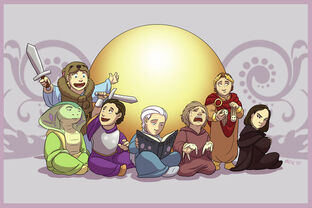- This page is written in the in-universe perspective of the "Garion" series' of novels.
Deities included the Gods, the major Demons, the destiny/destinies, the personification of the Universe (mother of the Gods), and possibly the Orb of Aldur and the Sardion. The seven Gods were brothers. The Demons were worshipped by the Morindim and Karands. The Universe was the Mother of the Gods.
In addition to these major deities, there were also minor demons (from Hell, ruled by its King), the sprites (mischievous beings from the Universe itself), and spirits (from the Spirit World, ruled by UL and his sons). The spirits included ghosts; humans, animals, or Monsters (including Dryads) who had died (but NOT including those who had destroyed themselves). Any necromancer could summon a ghost into the Universe. The God Mara summoned his entire country to the District of the Marags (Maragor) after their believed extinction at the hands of the Tolnedrans.
The Necessities[]
The power of the two Necessities is such that if they were to meet directly, the universe would likely be destroyed. Hence they work through agents, the Child of Light and the Child of Dark, and channel some of their power through the Orb of Aldur and the Sardion to be used by them.
Gods[]
The known Gods were UL and his seven children as well as Eriond, who would have been one of UL's children had the Destiny not split in two, and later replaced Torak as God of the Angaraks.
- UL, Albatross God of the Ulgos and the Monsters, Father of the Gods, unknown to the other races until the Battle of Vo Mimbre.
- Aldur, Owl God Apart (took some disciples instead of a people; eldest of the children of UL)
- Nedra, Lion God of the Tolnedrans (second eldest of the children of UL)
- Torak, Dragon God of the Angaraks (deceased; third eldest of the children of UL; only god to take a Monster as their totem animal. Slain by Belgarion at Cthol Mishrak)
- Chaldan, Bull God of the Arends
- Issa, Snake God of the Nyissans
- Mara, Bat God of the Marags
- Belar, Bear God of the Alorns (youngest of the original seven children of UL)
- Eriond, Horse God of the Angaraks and the Dals (successor to Torak as God of Angarak; would have been the original God of Angarak had the Destiny not split in two; implied to be set to become God of all other races as well)

Aldur would have been the God of the Dals (who split into the main group of Dals, as well as the Morindim, the Karands, the Melcenes, and the Ulgos). The main group of Dals did not have a God until Eriond, and had a strange religion that revolved around the two Destinies. The Morindim and the Karands worshiped Demons, who were not Gods but were another type of Deity. They later were joined into the Angarak religion, but they kept their Demon worshiping practices. The Melcenes did not have a God and spent their time studying subjects such as alchemy. The Ulgos split away from the Dals to search for a God of their own. They eventually found UL, but it took a lot of persuasion from the Ulgo leader, Gorim, to make him take the Ulgos as his people. The Sendarians, being a mixed race, worshiped Aldur, Nedra, Chaldan, Issa, Mara, Belar, and even recognised Torak, but they do not worship UL.
Demons[]
- The King of Hell was the ruler of the demons' universe, Hell. He constantly strove to break the chains in which he was bound by UL. He once hatched a plot to obtain the Orb of Aldur and the Sardion, in an attempt to use their power to free himself from Hell, and hurl UL into a prison of his making, but failed.
- Demon Lords were disciples of the King of Hell, and as such were the most powerful demons alive. They were far beyond the powers of most or all mortal summoners to control, only submitting as part of a deal (usually having ulterior motives in the Demon Lord's favour). It is not even certain that they flee from the power of the Orb, as lesser demons do, though a Demon Lord was shown to be outmatched by the power of a God on one occasion.
- Nahaz was the chief demon among the Karandese cult. He has waged a long war on Mordja, and sees his role in the War of Destinies, aiding Urvon, as simply a continuation of this. He was defeated and banished by Durnik upon his raising to disciplehood under Aldur.
- Mordja appears to have been the lord of the demons in contact with the Morindim. He entered the War of Destinies in aid of Zandramas, opposing Nahaz but with similar goals. Near the end of the conflict, he was trapped in the body of a dragon and killed.
- Lesser demons appear numerous times in the stories. They are occasionally named, though these names seem to be inventions of their summoners. Their relative rank and power seems to be indicated by size, with names (imps, fiends, afreets, and full grown demons) attached to the varying degrees at one point. However, this is not an exact science: the Demon Lord Nahaz almost always used a human-sized form (although his true form was monstrously huge), and summoned demons' shapes (and therefore sizes) are determined by the imagination of the summoner.
